Effect of 8-hydroxy-2-(N,N-di-n-propylamino)tetralin and MDMA on the discriminative stimulus effects of the classical hallucinogen DOM in rats
- PMID: 18778728
- PMCID: PMC3236028
- DOI: 10.1016/j.pbb.2008.08.013
Effect of 8-hydroxy-2-(N,N-di-n-propylamino)tetralin and MDMA on the discriminative stimulus effects of the classical hallucinogen DOM in rats
Abstract
Co-administration of the 5-HT1A serotonin receptor agonist (+/-)8-hydroxy-2-(N,N-di-n-propylamino)tetralin [(+/-)8-OH DPAT] enhances the discriminative stimulus effects of the classical hallucinogen 1-(2,5-dimethoxy-4-methylphenyl)-2-aminopropane (DOM) in rats. In the present investigation, using Sprague-Dawley rats trained to discriminate DOM (1.0 mg/kg) from saline vehicle under a VI-15 s schedule of reinforcement, it was shown that the stimulus-enhancing actions of 8-OH DPAT are related more to its R(+)-isomer than to its S(-)-enantiomer, and that the (+/-)- and R(+)8-OH DPAT-induced effects are antagonized by the 5-HT1A receptor antagonist NAN-190. (+/-)8-OH DPAT and its isomers substitute in rats trained to discriminate the designer drug N-methyl-1-(3,4-methylenedioxyphenyl)-2-aminopropane (MDMA; methylenedioxymethamphetamine) from vehicle indicating some similarity of effect. On this basis, it was hypothesized that MDMA might be capable of enhancing the DOM stimulus. Co-administration of MDMA with low (i.e., 0.1 and 0.3 mg/kg) doses of DOM resulted in greater DOM-appropriate responding than engendered by administration of DOM alone. As such, the present findings are the first to demonstrate an MDMA-induced enhancing effect on the discriminative stimulus actions of a classical hallucinogen. The results also suggest that a 5-HT1A serotonin receptor mechanism might contribute to this phenomenon.
Figures
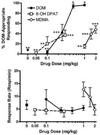
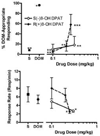
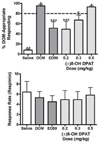
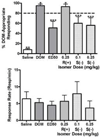
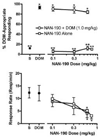
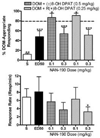
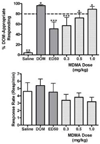
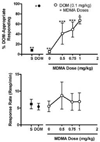
Similar articles
-
Differential effects of serotonin 5-HT1A receptor agonists on the discriminative stimulus effects of the 5-HT2A receptor agonist 1-(2,5-dimethoxy-4-methylphenyl)-2-aminopropane in rats and rhesus monkeys.J Pharmacol Exp Ther. 2010 Apr;333(1):244-52. doi: 10.1124/jpet.109.163451. Epub 2010 Jan 6. J Pharmacol Exp Ther. 2010. PMID: 20053932 Free PMC article.
-
MDMA stimulus generalization to the 5-HT(1A) serotonin agonist 8-hydroxy-2- (di-n-propylamino)tetralin.Pharmacol Biochem Behav. 2000 Jul;66(3):483-8. doi: 10.1016/s0091-3057(00)00174-x. Pharmacol Biochem Behav. 2000. PMID: 10899359
-
Modulation of a (+)amphetamine discriminative stimulus in rats by 8-hydroxy-2-(N,N-di-n-propylamino)tetralin (8-OH DPAT).Pharmacol Biochem Behav. 2006 Apr;83(4):612-7. doi: 10.1016/j.pbb.2006.03.025. Epub 2006 May 3. Pharmacol Biochem Behav. 2006. PMID: 16675002
-
Discriminative stimulus properties of the 5-HT1A agonist 8-hydroxy-2-(di-n-propylamino)tetralin (8-OH DPAT).Pharmacol Biochem Behav. 1986 Jul;25(1):135-9. doi: 10.1016/0091-3057(86)90243-1. Pharmacol Biochem Behav. 1986. PMID: 2944129
-
Role of training dose in drug discrimination: a review.Behav Pharmacol. 2011 Sep;22(5-6):415-29. doi: 10.1097/FBP.0b013e328349ab37. Behav Pharmacol. 2011. PMID: 21808191 Free PMC article. Review.
Cited by
-
Effects of serotonin (5-HT)1A and 5-HT2A receptor agonists on schedule-controlled responding in rats: drug combination studies.Psychopharmacology (Berl). 2011 Feb;213(2-3):489-97. doi: 10.1007/s00213-010-2136-9. Epub 2010 Dec 21. Psychopharmacology (Berl). 2011. PMID: 21174080 Free PMC article.
-
Discriminative stimulus properties of α-ethyltryptamine (α-ET) in rats: α-ET-like effects of MDMA, MDA and aryl-monomethoxy substituted derivatives of α-ET.Psychopharmacology (Berl). 2025 Jun;242(6):1407-1418. doi: 10.1007/s00213-024-06738-y. Epub 2024 Dec 28. Psychopharmacology (Berl). 2025. PMID: 39731580
-
Differential effects of serotonin 5-HT1A receptor agonists on the discriminative stimulus effects of the 5-HT2A receptor agonist 1-(2,5-dimethoxy-4-methylphenyl)-2-aminopropane in rats and rhesus monkeys.J Pharmacol Exp Ther. 2010 Apr;333(1):244-52. doi: 10.1124/jpet.109.163451. Epub 2010 Jan 6. J Pharmacol Exp Ther. 2010. PMID: 20053932 Free PMC article.
-
S(-)Propranolol as a discriminative stimulus and its comparison to the stimulus effects of cocaine in rats.Psychopharmacology (Berl). 2009 Apr;203(2):369-82. doi: 10.1007/s00213-008-1317-2. Epub 2008 Sep 16. Psychopharmacology (Berl). 2009. PMID: 18795268
-
The 2014 Philip S. Portoghese Medicinal Chemistry Lectureship: The "Phenylalkylaminome" with a Focus on Selected Drugs of Abuse.J Med Chem. 2017 Apr 13;60(7):2605-2628. doi: 10.1021/acs.jmedchem.7b00085. Epub 2017 Mar 15. J Med Chem. 2017. PMID: 28244748 Free PMC article.
References
-
- Aguirre N, Ballaz S, Lasheras B, Del Rio J. MDMA (“Ecstasy”) enhances 5-HT1A receptor density and 8-OH DPAT-induced hypothermia: Blockade by drugs preventing 5-hydroxytryptamine depletion. Eur J Pharmacol. 1998;346:181–188. - PubMed
-
- Balster RL, Ford RD. The discriminative stimulus properties of cannabinoids: a review. In: Ho BT, Richards DW III, Chute DL, editors. Drug Discrimination and State Dependent Learning. NY, NY: Academic Press; 1978. pp. 131–147.
-
- Bishop C, Taylor JL, Kuhn DM, Eskow KL, Park JY, Walker PD. MDMA and fenfluramine reduce L-DOPA-induced dyskinesia via indirect 5-HT1A receptor stimulation. Eur J Neurosci. 2006;23:2669–2676. - PubMed
-
- Bonaventure P, Nepomuceno D, Hein L, Sutcliffe JG, Lovenberg T, Hedlund PB. Radioligand binding analysis of knockout mice reveals 5-hydroxytryptamine7 receptor distribution and uncovers 8-hydroxy-2-(di-n-propylamino)tetralin interaction with α2-adrenergic receptors. Neuroscience. 2004;124:901–911. - PubMed
-
- Colpaert FC. Discriminative stimulus properties of narcotic analgesic drugs. Pharmacol Biochem Behav. 1978;9:863–887. - PubMed
Publication types
MeSH terms
Substances
Grants and funding
LinkOut - more resources
Full Text Sources
Other Literature Sources
Medical
Research Materials

